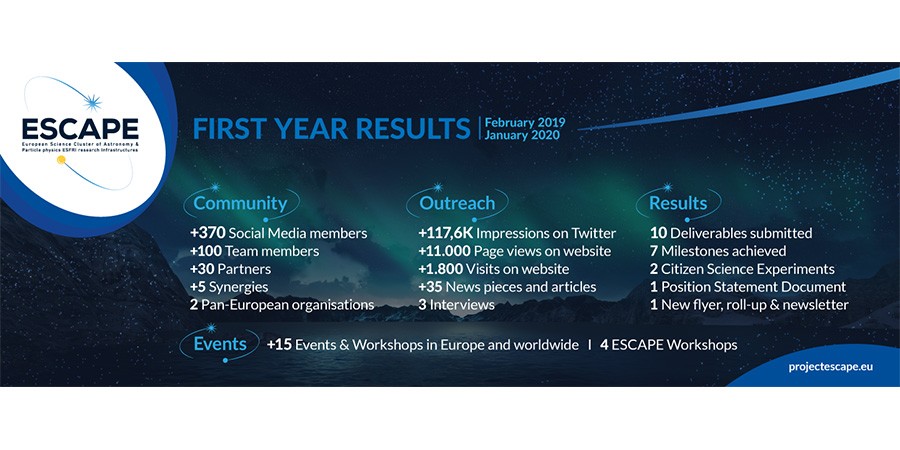ESCAPE – Versatile Working Solutions for astronomy, astroparticle and particle physics whilst stimulating the EOSC implementation

Open science promotes collaborations that are key to pushing the boundaries of data-driven scientific research, by connecting researchers across the globe and increasing discoverability and visibility. The ESCAPE Horizon 2020 project is the European Science Cluster of Astronomy and Particle Physics that provides an open-source scientific software and service repository. Its goal is to enable open science as part of the drive to a European Open Science Cloud (EOSC).
To take stock of progress, ESCAPE organised a meeting in late February at the Royal Library of Belgium, bringing together the consortium members, its General Assembly members and External Expert Advisory Board members, as well as EOSC stakeholders.
The meeting zoomed in on the main results achieved during the first year of ESCAPE in the drive towards the development of the “ESCAPE Astronomy and Particle/Nuclear Physics Cell” that will enable EOSC to adopt services transversally, and coupled with e-infrastructures that will help support other disciplinary “cells”. Now entering its second year, ESCAPE is looking forward to sharing its outcomes and engaging with its ESCAPE stakeholder community.
Trust-IT's role in ESCAPE
Trust-IT leads the Public Engagement and Communication activities to each one of the ESCAPE stakeholders. ESCAPE is creating a cross-border, multi-disciplinary environment that benefits both EOSC and the ESFRI projects, by exploring standards, prototyping and deploying advanced open data services that follow FAIR principles of findable, accessible, interoperable and reusable across the various stages of the scientific process.
The five services of ESCAPE provide innovative solutions for the management, curation, and deposition of data, for the data driven science economy, spanning major domains in fundamental research: astronomy, astrophysics, astroparticle physics, high energy physics, particle and nuclear physics. ESCAPE service factsheets with details on functionalities in each one with rollout over the project’s 42-month lifecycle.
The ESCAPE community was created early on in the project and now counts more than 350 members from Twitter and LinkedIn as some of the main stakeholder engagement channels to raise awareness and share updates on ESCAPE, including, the website, communication materials, participation at third-party events worldwide and the organisation of ESCAPE workshops.
Other Highlights of Year 1
Year 1 was the ramp-up period to set up the main tasks to develop ESCAPE services. The “ESCAPE Virtual Observatory” started the interaction with a variety of organisations to test service publishing, as well as identified some requirements from the ESFRI projects to use the services, as well as the “ESCAPE Science Analysis Platform”. “ESCAPE Open-source scientific Software and Service Repository” created five focus groups to better support the creation of an open data access repository towards open science. “ESCAPE Data Infrastructure for Open Science” defined the implementation plan and the design of the pilot Implementation plan and the design of the of the data lake pilot, with an assessment of the first version in a year time. “ESCAPE Citizen Science” launched its first experiment, called Clump Scout, with over 720 thousand classifications from over 6.500 volunteers.
An Open Science Vision
Open science promotes collaborations, taking analyses to new frontiers through enhanced data research. Practising open science makes it easier for researchers to connect with each other because it increases the discoverability and visibility of their work. This, in turn, enables easy access to novel data and software resources. Sharing data and knowledge transfer within and across scientific communities is crucial for accelerating scientific discoveries and increasing the value of research. ESCAPE is the key driver of this vision for astronomy, astroparticle and particle physics.
Multi Disciplinary Efforts across Cluster Projects
To enhance the impact of research science, it is crucial to work on cross-domain working solutions that are applicable across fields. It became clear during the ESCAPE meeting in February 2020 that it is important to leverage the Test Science Project (TSP) approach with the goal of federating collaborative actions among researchers, and potentially from diverse scientific domains. The idea is to pursue this idea with the other cluster projects like ESCAPE in the coming months to pull out some relevant cross-cluster working and multidisciplinary use cases to demonstrate as an outcome during Q4 of 2020 at outreach events organized by the EOSC stakeholder engagement teams. Trust-IT has been supporting this effort as a community engagement activity as part of its mandate in EOSCSecretariat.eu for 2020 & 2021.
Next steps
The second year will be focused on collecting feedback and performing tests with future service users (the ESFRI projects) to ensure the sustainability of ESCAPE services in the long term. It is crucial to increase stakeholder engagement to stimulate adoption of ESCAPE results and, for this, workshops and summer schools are being organised, to perform assessments, develop initial pilots and test science projects. All in all, the second year will prioritise the service value proposition of ESCAPE services.
- Learn more about ESCAPE work at https://projectescape.eu/
- Discover the ESCAPE catalogue of services
